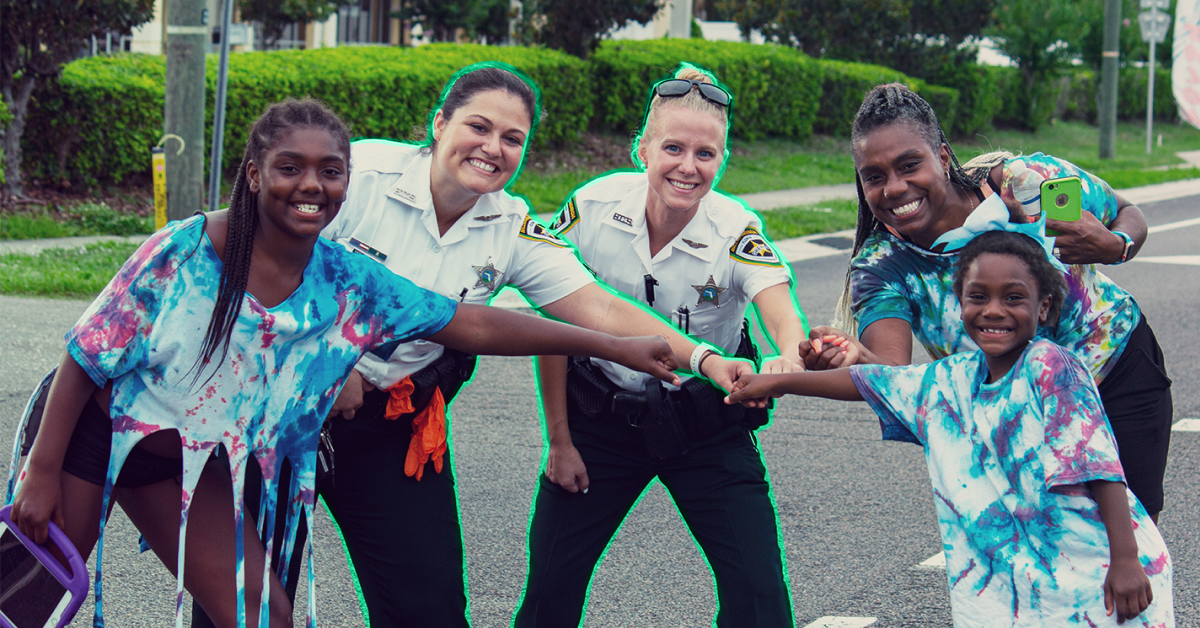The top benefits of community policing to police-community relations

Tim Evans
Account Executive
Is community policing the solution to systemic police reform in the United States?
It’s no secret that 2020 was a challenging year in the United States for law enforcement, nation-wide. The year shed light on just how strained relations are between police departments and the communities they serve as well as just how big the trust gap is. In a survey conducted by the Police Executive Research Forum (PERF), police chiefs widely identified that rebuilding trust was a top priority in the year ahead, affirming the steep decline in community-police relations and a step towards the values of community policing.
Law enforcement agencies have been deploying community policing practices—sometimes called community-oriented policing (COP)—since the 1970s, but as demand for police reform has increased, there has been a renewed interest in community policing as a means to systemic reform.
What is community policing?
Community policing is a framework that aims to improve quality of life and increase public safety through collaboration between police officers and community members. In community policing, the job of the police is not just to respond to incidents, but also to help solve community problems; to problem-solve not just for residents, but with residents.
What are the benefits of community policing?
At a pivotal moment in time for the future of policing, law enforcement agencies that haven’t yet been part of the community policing wave could certainly benefit from taking a closer look at the philosophy behind COP. At their core, the benefits of community policing derive from a strong focus on improving community relationships and building community partnerships. While crime reduction can be thought of as a bottom-line benefit to community policing, there are a number of other benefits as well—benefits which also directly or indirectly positively affect crime reduction. Here are the top recognized benefits of community policing:
- Improved officer morale: The national narrative around policing has had a significantly negative impact on officer morale and caused many in the field to question the future of policing and their role in it. However, in police departments when officers feel supported by their community, chiefs report that morale is often higher and perhaps less impacted by national trends. That’s not only because community policing is good for positive relations, it’s also because community policing creates more opportunities for public and visible displays of support from the community, which is a positive thing for officers to experience.
- Higher officer retention: One of the domino effects of 2020 and low officer morale has been a serious problem with police officer retention (paired with soaring retirement rates)—a challenge which continues to plague police departments in 2021. Officers with better morale, who feel appreciated by their community—even when tough incidents take place—are more likely to stay at their jobs, just like in any other profession. This is because when community members know their local officers, one bad apple in a department is exactly that: just one bad apple.
- Ease of hiring: In parallel to challenges with officer retention, police departments have also been plagued with new struggles in hiring, exacerbating the crises many police departments are facing. Higher officer retention, better morale, and a better image in the community all translate—just like in any other organization—into easier hiring. In parallel, there are federal incentives for law enforcement agencies to hire under community policing development frameworks.
- Increased trust & improved community relations: The ethos of community policing creates opportunities for interactions between community members and police officers not just in the context of responding to crime. This means more interaction in general, but more importantly, it means more positive interaction. The formula here isn’t rocket science: when residents whose only contact with law enforcement has been in the context of crime suddenly have the chance to engage with their local police officers in other ways, human relationships form and community relations are improved. Studies support this showing that positive contact with police “substantially improves” attitudes toward police.
- Improved safety for officers & community members: When residents increase their trust and respect for local officers, and vice versa, everyone—officers and residents—is safer. Trust and positive relationships increase willingness to cooperate and decrease fear, which in return contributes to de-escalation and increases safety—both perceptions of safety and actual, physical safety—for all involved.
- Improved police department efficiency: At a time when scrutiny of police budgets and resident engagement about police department activity have skyrocketed, community policing can actually help police departments be more effective and resource-efficient. Community policing can be thought of as “democracy in action” because it demands civic participation, which in turn enables police departments to understand directly from residents what their most pressing needs and priorities are, allowing departments to aim limited resources at addressing these expressed needs.
There’s a wonderful snowball effect that results from the benefits of community policing: engaging with residents about their needs and addressing them also increases transparency and accountability, which, you guessed it, increases trust and improves community relations.
But … does community policing reduce crime?
Community policing centers on the idea that solving for community problems and not just responding to criminal incidents will reduce crime. Research conducted on community policing suggests that it does reduce crime, and the U.S. Attorney’s General’s office has also affirmed this, providing different community policing initiatives as “promising strategies” for combating criminal activity. For example, youth outreach programs in Denver, Colorado which include free summer activities, are a classic COP initiative. However, the truth is much of the research out there on community policing and crime is outdated. Hopefully renewed interest and renewed federal investment in community policing will also be supported by research and backed-up by easily-adoptable best practices.
What are the recognized problems of community policing?
It goes without saying that even with recognized benefits to community policing, there are certainly criticisms of community policing as well. Many of these criticisms center around the practice of community policing, rather than the theory. In theory, community policing is intended to benefit everybody, not only certain groups, but in practice, it has been criticized for only helping some and even for causing harm to others. Criticisms of community policing include:
- That it favors certain community members (white, middle-class) or only strongly benefits specific community interests – for example, those of local business owners.
- That it can be a mask for embedding more police officers in communities where distrust in police officers is already high. Rather than improving relations and partnering with local leaders and community members, this simply increases police presence and increases policing.
- That it is a superficial solution rather than a cultural shift – and without real organizational change, it cannot work. In this way, community policing is too dependent on leadership and having the right leader.
- That it is a multi-stakeholder framework – and community involvement is just as important as the officers involved. When the baseline for community policing is distrust, it’s unrealistic to ramp up and change things.
How can an agency deploy community policing effectively?
Even with these criticisms, there are many who celebrate the positive effect of community policing. Effective community policing requires altering a police department’s policies, practices, and guiding philosophies. But to really understand whether a police department’s deployment of community policing is effective (or if community policing actually works generally), police departments need to have a way to continuously measure more than just crime. They also need to be able to measure trust among their constituents – and to do so in a representative way so that they don’t fall into one of the pitfalls of community policing, only benefiting certain groups (the white, middle-class, who already engage positively with police). This is the critical difference between solving for community problems via COP – and merely solving for crime.
While law enforcement agencies in the U.S. have been using crime stats since the 1930s, the idea of data around trust is more novel. Good data aggregated through technologies like Zencity’s can help law enforcement agencies measure and follow trust scores amongst all community members to identify whether community policing and other efforts are actually helping to improve community relations.
A fantastic example of a police department that has been effective both in deploying community policing and in measuring its impact is the Redondo Beach Police Department. Redondo Beach PD has used Zencity to increase trust between the Department and its community members, reinforce positive practices, deploy resources according to its community’s priorities, and to tackle public safety issues, like homelessness. The Police Chief is doing this with continuous, representative, community-wide surveys – gauging trust levels and perceptions of safety by neighborhood and adjusting accordingly.
Redondo Beach is just one example of community policing done well and done effectively. There is much to be learned from police chiefs and police departments across the nation, and significant resources dedicated to helping officers and departments onboard with COP philosophies and practices.
%20copy-1.png?width=544&height=120&name=Logo_black%20(1)%20copy-1.png)



